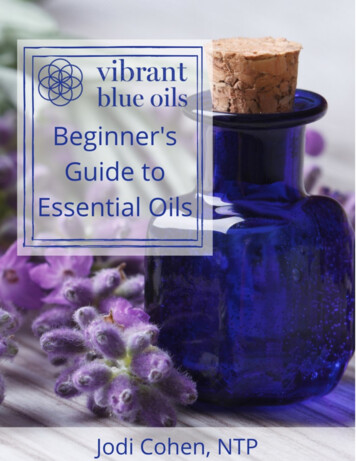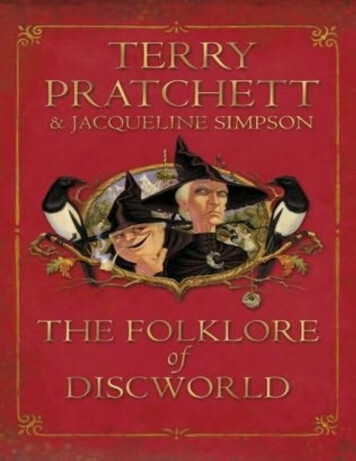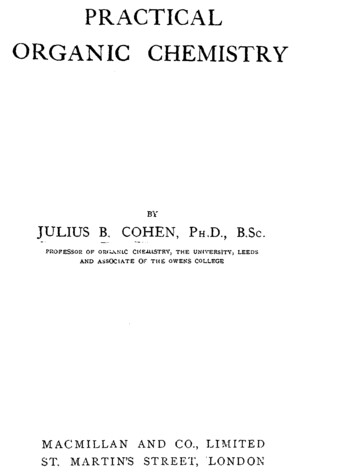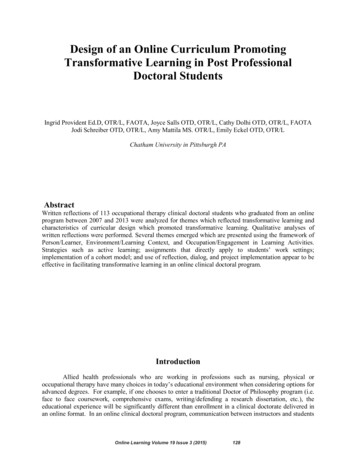
Transcription
1
Welcome . .3Disclaimer and Copyright . . .3Introduction . .4How Essential Oils Work . . .5Vibrant Blue Oils Commitment . .6Proprietary Blends . . .7History of Essential Oils .8Chemistry of the Oils . .9Methods of Extraction .10How To Use Essential Oils . .11Application and Dosage . .12Dilution .12How to Dispense Essential Oils .13Storage and Care . .13References .142 2016 by Vibrant Blue Oils LLC.
I’m Jodi Cohen, Founder of Vibrant Blue Oils. My intention with the Beginner’s Guide to EssentialOils is to help ease the overwhelm by giving you a brief overview of the history and science behindessential oils along with best practices for using them.As a nutritional therapy practitioner, I have personallyexperienced and observed the power of essential oils toshift and balance health challenges, including: SleepAnxiety and DepressionStress and Adrenal exhaustionDigestionFocus and Brain FogDetoxificationSystemic Inflammation, often including Leaky GutBlood Sugar IssuesBut I also know that any new tool can feel confusing and overwhelming. That’s why we created thisshort quiz to help you identify the best oils for getting started.Our intention at Vibrant Blue Oils is to empower you with the resources and information to supportyour vibrant health. I recognize that a body in balance can heal. Imbalances in the body, the brain orthe emotions can throw the body out of balance and present as disease. Our proprietary therapeuticessential oil blends are designed to help return these key systems to balance, along with helping toreduce symptoms like pain, fatigue, and mood imbalances, so the body can heal.It is my hope that this guide and our products serve as a useful bridge to amplify the success of yourother healing modalities, and with it, your vibrant health.In Vibrant Health,JodiAll information provided within this Guide is for informational purposes only, and is not to be construed asmedical advice or instruction. Please consult a qualified health professional on any matters regarding yourhealth and wellbeing or on any opinions expressed within this guide. The information provided in this Guide isbelieved to be accurate based on the best judgment of the author, but you as the reader must be responsiblefor consulting with your own health professional regarding your personal health plan. Vibrant Blue Oils cannotaccept any responsibility for the actions or consequential results of any action taken by any reader. Thesestatements have not been evaluated by the Food & Drug Administration. Any products discussed are notintended to diagnose, treat, cure, or prevent any disease.We encourage you to share The Beginner’s Guide to Essential Oils by directing family, friends or clients toVibrantBlueOIls.com where they can sign up for this book directly. Please do not copy or republish any part ofthis book. No part of this publication may be reproduced, distributed, transmitted, or sold in whole or in part.Thank you for respecting the time and energy that was put into this guide for your education.All content 2016 by Vibrant Blue Oils LLC.3 2016 by Vibrant Blue Oils LLC.
Essential oils are the natural, highlyconcentrated essences extracted from specificherbs in their living state for their healingcapabilities. Essential oils can be derived fromplants, shrubs, flowers, grasses, fruits, bushes,seeds, roots, bark and trees.This shared chemistry makes essential oilshighly compatible with human biochemistry.Essential oils are also lipid-soluble with a proteinlike structure similar to human cells, making themeven more compatible with human cells andtissues.Essential Oils provide key components of theplants’ immune systems. They help the plantsgrow, thrive, evolve, and adapt to surroundings.For example, they protect plants from bacterialand viral infections, heal injuries, repel unwantedinsects, prevent water loss and otherenvironmental damage, play a role in plantpollination and deliver oxygen and nutrients intothe cells. This is why they are “essential” for aplant -- without them, plants could not survive.Since essential oils are bio-familiar to humans,they can also help balance and support thehuman body to heal itself. Research has shownthat essential oils help us fight infection (with antibacterial, anti-fungal and anti-viral properties),balance hormones and emotions and aid inregeneration. Essential oils also help the brain,reviving a tired mind and stimulating memory.Different fragrances of essential oils will relax,revitalize or renew your mind, body and soul.In the human body, they play a similar role -transporting valuable nutrients to the cells. Thisis because the three primary elements - carbon,hydrogen and oxygen - are common to bothhuman beings and essential oils.Highly concentrated essential oils are alsoextremely potent. A drop or two can producesignificant results because an entire plant, whendistilled, might produce only a single drop ofessential oil. They are approximately 75-100times more concentrated, and consequently farmore4 2016 by Vibrant Blue Oils LLC.
Essential oils can help us return to our naturalremains grounded and constant. So if we can alignstate of balance, known as homeostasis, so that we ourselves with that grounded energy of nature, itcan help us return to and stay in balance.can heal.There is something in nature that holds that consistent frequency and consistent balance. This isThere is a balance in nature – the tides, thewhere I believe the benefits of essential oil lie –seasons, the moon cycles all ebb and flow in balhelping our bodies reconnect to nature and ourance. I believe that our bodies were designed tointernal sense of balance.maintain a similar natural rhythm.Just as you can reboot or repair a computer, weWhen we lose this connection to nature, it interbelieve the body’s software code can also be referes with our internal rhythm and balance, impedpaired and rebooted and plants and essential oilsing our ability to sleep, to detoxify, to digest, tocan play a critical role in the process.anti-inflame and relax.You see, humans and plants are bio-familiar. ThisWhen our bodies are in a balanced state, these natmeans that in essence we both use the same softural processes flow easily without interference. Theware codes, called frequencies, with each plantbody can easily recognize or respond to a stressor,having its own unique frequency much as youthen return to balance.would perceive a unique color.Connecting with nature – either by consuming nutrient-dense whole food and minerals or inhalingor topically applying essential oils derived fromplants — allows us to align with the balance of nature so our bodies can return to balance and heal.Just as you can mix paint colors to match a wall,you can mix the frequencies of different plantsthrough the use of their oils to match the frequency or code of a particular organ, brain or emotionalenergy.The definition of balance is to “maintain a steadystate to avoid falling”. Falling into ill health, negative thoughts, depressed or anxious mood. As ourthoughts shift, so does our balance. But natureremains steady. Plants, trees, rocks – their energyThis is what we are doing with the Vibrant Blue Oilblends – blending the frequencies of differentplants to match the frequency of the body, brainand emotions in balance.5 2016 by Vibrant Blue Oils LLC.
Created by Practitioners for PractitionersVibrant Blue Oils was founded by nutritional therapy practitioners who observed that certain lifestylechallenges -- sleep issues, constant stress, anxiety, depression and exhaustion -- impeded the body’sability to heal. Our exploration of non-invasive, natural solutions lead us to pure organic and wildcrafted essential oils. We have been amazed at how effectively they balance and relieve emotional, hormonal, digestive, immune, detoxification and nervous system challenges.Vibrant Blue Oils is committed to: PROPRIETARY BLENDS: The Vibrant Blue Oils proprietary blends are uniquely formulated frompure organic or wild-crafted essential oils to balance the body, brain, emotions and supportsymptoms for support optimal healing. These proprietary blends are designed to work with dietarychanges, providing specific plant and herb nutrients to support healing in a bio-available form thateven those with digestive challenges can easily assimilate. THERAPEUTIC QUALITY: Vibrant Blue Oils are the highest quality, properly extracted essential oilsfrom wild-crafted, organic plants grown in their indigenous locations. They are pure from anyadulteration. As a testament to their purity, Vibrant Blue Oils are packaged in cobalt blue bottlesthat protect and preserve the natural energy carried within the oil. ENHANCING KNOWLEDGE: Vibrant Blue Oils believes that essential oils are very powerful healingmodalities that need to be used properly for optimal impact. For this reason, we are committed toeducating health care providers and end users on the oils, their proper use and application.6 2016 by Vibrant Blue Oils LLC.
Vibrant Blue Oil blends have been created with the intention of bringing the body into balance soclients can heal. In many ways, blends are more powerful than single oils. They are created whenseveral single essential oils have been synergistically combined to create something that is greaterthan the sum of its parts.The combination yields not only the power of the combined chemical constituents and frequencies,but also the synergy of how they interact together. This means that the respective powers of theindividual oils change to enhance their energy. For example, the anti-inflammatory effects of chamomile are increased when combined with lavender.The Vibrant Blue Oils includes uniquely formulated, proprietary blends developed to balance organsystems and support optimal healing. These blends have been designed to work in tandem withdietary changes, providing specific plant and herb nutrients to support healing in a bio-availableform that even those with digestive challenges can easily assimilate.Many practitioners report the experience of seeing the client’s body completely shift after applyingthe blends. We are both excited and encouraged by the potential of essential oil blends to dramatically assist in challenging areas of our practices and are committed to ongoing research and product development in that area.7 2016 by Vibrant Blue Oils LLC.
Throughout history, the essential oils of plantswere used in many cultures for their medicinaland therapeutic benefits. The Egyptians were renown for using essential oils extensively in medical practice, beauty treatment, food preparation,and in religious ceremony. Frankincense, sandalwood, myrrh and cinnamon were considered veryvaluable cargo along the ancient caravan traderoutes and were sometimes exchanged for gold.Borrowing from the Egyptians, the Greeksused essential oils in their practices of therapeuticmassage and aromatherapy. The Romans alsoused essential oils to promote health and personal hygiene. Influenced by the Greeks and Romans,as well as Chinese and Indian Ayurvedic use of aromatic herbs, the Persians began to refine distillation methods for extracting essential oils from aromatic plants. Essential oil extracts were usedthroughout the dark ages in Europe for their antibacterial and fragrant properties.More recently, the powerful healing properties ofessential oils were rediscovered in 1937 by aFrench chemist, Rene-Maurice Gattefosse, whoplunged his badly burnt hand into a vat of lavender oil (mistaking it for water) and was surprisedto see no injury or scarring. A French contemporary, Dr. Jean Valnet, used therapeutic-grade essential oils to successfully treat injured soldiersduring World War II. Dr. Valnet went on to becomea world leader in the development of aromatherapy practices.With the invention of synthetic drugs, the use ofplants & herbs for their therapeutic propertiestemporarily declined. That trend is reversing ashealth scientists and medical practitioners continue to research and validate the benefits of therapeutic-grade essential oils to protect the body,boost the immune system, and revitalize the mindand influence mood, without the negative sideeffects commonly associated with synthetic drugs.8 2016 by Vibrant Blue Oils LLC.
The therapeutic benefits of the oil are often relatedto the compound(s) at the highest amount in theoil. In general, essential oils can be subdivided intotwo distinct groups of chemical constituents:1. HydrocarbonsMade of terpenes which inhibit the accumulationof toxins and help discharge existing toxins fromthe liver and kidneys. Key terpenes include:· Monoterpenes – (Found in Grapefruit, Orange,and Balsam Fir) Inhibit the accumulation of toxins,detoxify kidneys and liver, enhance balance, restoreinformation in DNA.· Sesquiterpenes – (Found in Cedarwood, Sandalwood and Myrrh) Antiseptic, anti-inflammatory,stimulate liver, increase oxygenation around thepineal and pituitary glands, can surpass the bloodbrain barrier and enter the brain tissue.The chemical profile of an essential oil determines its viscosity, volatility and medicinalproperties.The molecular structure of essential oils arering like and far more complex than the simpler, linear carbon-hydrogen structure of fatty oils. The essential oilchains are held together by carbonatoms linked with oxygen and hydrogen, along with nitrogen andsulfur atoms (which are not foundin other non-essential plant oils).2. Oxygenated compounds· Alcohols (found in Ravensara, Geranium, Rosewood) – Uplifting, high resistance to oxidation, antiseptic, antiviral, revert cells to normal function.· Aldehydes (found in Cinnamon Bark, Lemongrass)- Calming, relieve stress and blood pressure, sedative, antiviral, anti-inflammatory.No two essential oils are alike intheir structure and each oil is comprised of a combination of hundreds - eventhousands - of different natural chemicals. Theaverage essential oil may contain anywherefrom 80 to 400 known chemical constituents,making them ideal for killing and preventing thespread of bacteria.· Esters (found in Lavender, Bergamot, Valerian andRoman Chamomile) - Balancing, relaxing andcalming, antifungal, anti-inflammatory and antispasmodic.While synthetic antibiotics often containonly one active chemical allowing bacteria (like MRSA) to mutate to survive theattack, the large and varied number ofantiseptic and antibacterial constituentsin essential oils make it impossible forbacteria to mutate enough to surviveeach and every one. This is what makesessential oils such effective, natural antibiotics.· Oxides – (Found in Ravensara, Rosemary and Eucalyptus) derived from other compounds such asalcohols, terpenes or ketones which have beenoxidized. Can be mildly stimulating.· Ketones (found in Hyssop, Patchouli Rosemary,Sage) - Calming, sedative, stimulate cell and tissueregeneration, liquefy mucous.· Phenols (found in Oregano, Thyme Clove and TeaTree) - Stimulating to the nervous and immune systems, highly antibacterial/antimicrobial antioxidant,clean cell receptor sites.9 2016 by Vibrant Blue Oils LLC.
The few exceptions are hydro distilled, coldpressed, and absolute extraction.The chemistry and therapeutic potential of essential oils are a direct result of how they are grown,harvested and processed. To ensure optimalquality, essential oils need to be grown and harvested from the ideal soil, carefully extracted atthe perfect moment by experienced growers.We strive to find the highest quality essential oilsfrom around the world and work with small farmsthat grow the plants organically and then distillthem properly (low temperature and no/low pressure). A plant grown in the "proper" part of theworld will produce an oil of superior quality. Ouressential oils are either certified organic, organically grown (grown organically but not certified,some countries do not offer this certification), orwild (grown by nature). We intentionally use onlyorganically grown crops as toxic pesticide residues can become highly concentrated in the oils.Other important factors that influence the qualityof oils include the time between harvesting anddistillation, distillation equipment, temperature,pressure, and when to stop distillation in order toavoid exposing the oils to excessive heat, thus destroying vital constituents. Almost all of our oilsare distilled using low temperature and low pressure steam distillation.Steam Distilled: The most common method of extracting an essential oil from the plant is throughsteam distillation. Low temperature and low pressureplay an important role in collecting the highest quality essential oil. The plant is placed in a chamber andsteam is circulated under pressure through plant material releasing the essential oils into the steam. Thesteam and essential oil are then carried out of thechamber and cooled. As the steam mixture cools, thewater and oils naturally separate and the oil is collected in its pure form. Several factors contribute tothe quality of oil including temperature and pressure-- Too little heat and pressure will not release valuable oil while too much can diminish the oils composition, potency and therapeutic potential — time distilled and materials used to construct the steamchamber .Hydro Distilled: The plant is distilled using waterrather than steam. The plant matter is placed in achamber filled with water, which is then heated untilthe oil is released. This extraction process produces asuperior quality essential oil, but it also is quite a bitmore labor intensive and therefore more expensive.Cold Pressed: When essential oil is pressed from theplant. This is the most common method of extractionfor citrus oils (Tangerines, Grapefruits, Lemons andOranges). The peel of the citrus plant is pressed andthe essential oil is then filtered from the plant matter.While this method uses no heat and therefore produces a superior quality essential oil, there are a fewdrawbacks to this extraction method, including residue of waxes and peel in the oil.Absolute: This method uses a solvent or chemical toextract the oil. Once the oil is extracted, the chemicalis then removed from the oil. Oils extracted as an absolute will always have some of the chemical remaining. A high quality absolute will have less than 1% ofsolvent remaining. Some plants, like Jasmine for example, will only give up their oil using this extractionprocess. Therefore there is no such thing as Jasmineessential oil but there is Jasmine absolute.10 2016 by Vibrant Blue Oils LLC.
Essential oils can be absorbed into the body via:Inhalation: Our sense of smell influences many physiological pathways including the stimulation ofhormones and other metabolic processes. When an essential oil is inhaled, it enters the nose, movesto the lining of the lungs, where it is then absorbed into the bloodstream within seconds. Researchhas shown that aromatic compounds exert strong effects on the brain, especially on the hypothalamus (the hormone command center of the body) and the limbic system (the seat of emotions). Someessential oils can dramatically increase oxygenation and activity in the brain.Topical Application: Due to their natural molecular composition, essential oils are easily absorbedby the skin and can be safely applied topically. When applied to the skin, essential oils quickly penetrate into the pores, moving rapidly through the cells into the bloodstream for internal benefitthroughout the body. For example, an essential oil placed on the foot will be distributed to every cellin the body in 21 minutes. They will even penetrate a finger or toe nail to treat fungus underneath.This also means that topical application of essential oils can have immediate, localized benefit to thetarget area of application. They can also be administered through the absorbent tissues of the bodyorifices (suppositories or orally enemas). The longer essential oils stay in contact with the skin, themore likely they are to be absorbed, so don't wash them off too soon.Ingestion: We do not recommend ingesting essential oils as they usually do not make it through thedigestive track to the area you are trying to treat. We have found topical applications to be moreeffective. For example, oils touted for internal use of digestive distress, like peppermint oil, can alsoproduce the same results when massaged on the stomach. Another internal option would be toplace a drop of essential oil on the inside of the cheek which allows the oils to be absorbed directlyinto the bloodstream. While many essential oils are generally regarded as safe for dietary use, someoils should not be taken internally. Do not use an essential oil internally if it does not list appropriatedietary supplement facts on its label.11 2016 by Vibrant Blue Oils LLC.
Essential oils are highly concentrated in theirpure and unadulterated form making them verypotent. In other words, a little (1-2 drops) can goa long way toward providing beneficial and effective results.The bottom of the feet are one of the safest andmost effective spots on the body for applying essential oils (especially when working with anyonewith young children or anyone suffering fromcompromised health). The thick skin on the solesof our feet are unlikely to produce skin irritations.This makes the feet a great place to apply someof the “hotter” oils and anti-infectious blends. Also, the numerous nerve endings on the soles ofthe feet can help carry the oils into the bloodstream very quickly. If you want to try it out, rub aclove of garlic on the bottom of your foot. Within 15minutes, your breath will smell of garlic.Because essential oils are highly concentrated, itis often recommended that they be diluted witha carrier oil -- a cold-pressed vegetable, nut, orseed oil -- especially for young children.To treat a specific area like a sore muscle, rash,burn or wound, apply the oils directly on the problem spot. Other good areas for applying oils are thebase of the throat, inside elbows and knees, and the Carrier oils allow for more controlled absorptionnape of the neck.into the skin as essential oils are “volatile” andcan evaporate quickly. Dilution with carrier oilsThe scalp is another good area for applying essenalso help maintain the scent of an essential oiltial oils because the size of the hair follicle is muchfor a longer duration of time and allows the uselarger than the pores in the skin. Rubbing oils onof a small amount of essential oil across a largethe scalp allows easy access for the essential oil.surface of skin. It also lessens the intensity ofThe essential oils can also soothe or stimulate the"hot" oils. In their natural form, essential oils canscalp. The act of massaging the scalp promotes the be very potent.removal of toxins and can alleviate stress by slowingmental activity.Many prepared blends, like Vibrant Blue Oilblends, have already mixed with a carrier oil. ForEssential oils should last between 12 - 24 hours inalmost all people these oils are ready to usethe body, Certain factors, such as viscosity, concen- straight from the bottle. For single oils, especiallytration, application method (topical or inhalation),“hot” oils like cinnamon, clove or peppermint oil,skin type and the area of the body where the oilsuse 1 or 2 drops of essential oil with a smallwere applied, can extend or diminish the therapeu- amount (1/4 teaspoon) of carrier oil. Some goodtic duration. In addition, the condition of the skincarrier oils include:affects the degree to which oils are absorbed. For Almond Oilexample, a hot bath hydrates the skin making it Jojoba Oilmore permeable for the oils. In addition, dry, Olive Oilcracked or damaged skin can also be more permea- Grapeseed Oilble, so essential oils should be applied cautiously. Avocado Oil12 Coconut Oil 2016 by Vibrant Blue Oils LLC.
Essential oils are best dispensed by holding the bottleof oil 1 to 4 inches above the fingers or palm of theother hand. Tip it over and wait for the oil to drip out.Some oils, like the Vibrant Blue Oil Calm and Sleepblends flow very quickly, while others are thicker andrequire a gentle shake. If possible, avoid touching thecenter of the drop dispenser -- let the oil drip fromthe edge freely.If an essential oil feels too hot or causes any redness,put a carrier oil, like olive or coconut oil on top of theessential oil. The carrier oil will dilute the essential oiland cause slower absorption. This will also diminishor stop the irritation while continuing to provide thetherapeutic benefits of the oil. After you have appliedenoughcarrier oil to stop the reaction, you canthen use soap and water to wash it all off. Waterdoes not work as well initially for an essential oil reaction as it traps the oil against the skin and can increase irritation.Essential Oils are called “volatile,” which means thatthey evaporate very quickly. Because of their volatile nature, they need to be kept in dark colored,preferably blue glass bottles (to protect them fromultra violet light) with airtight seals and away fromheat, preferably in a cool dark space. The airtightseal prevents oxidation and keeps the volatile components of the essential oils in the bottle, therebyretaining their traditional healing properties.Essential Oils do not come with an expiration date,but optimum shelf life is approximately two years.After this time they lose some of their potency. Citrus oils (orange, lemon, lime, etc.) tend to degrademost quickly (six month shelf life). However, someessential oils, such as Rose, Jasmine, EucalyptusGlobulus, Patchouli and Cypress actually becomemore potent with age.Some essential oils' scents will change regardless ofhow they are stored. The scents do not go bad orturn rancid they simply lose their subtlety. Although some choose to refrigerate their oils, this isnot necessary (except rose) and can be disadvantageous because some essential oils are solid at lowtemperatures.13 2016 by Vibrant Blue Oils LLC.
Here’s what you can do next:Step One: Take our FREE Self -Assessment Quiz todetermine the best oils for your Vibrant health!Step Two: Head over to the Vibrant Blue OilsFacebook Discussion Group and join us. There isnothing out there quite like this community. It givesyou the insight and knowledge on essential oils andnutrition that you’re going to love.14 2016 by Vibrant Blue Oils LLC.
Davis, Patricia. “Aromatherapy, an A-Z : The Most Comprehensive Guide to Aromatherapy Ever Published.” Random House UK, 2005.Deardeuff, LeAnne and David. “Inner Transformations Using Essential Oils.” Yl Wisdom LLC, 2006.Deardeuff, LeAnne. “Ultimate Balance.” Essential Science Publishing, 2009.Lawless, Julia. “The Illustrated Encyclopedia of Essential Oils: The Complete Guide to the Use of Oils inAromatherapy & Herbalism.” Element Books Ltd., 1995.Gattefosse, Rene-Maurice and Tisserand, Robert “Gattefosse's Aromatherapy: The First Book on Aromatherapy.” Random House UK, 2004.Gumbel, D., Principles of Holistic Skin Therapy with Herbal Essences, Haug Publishers, 1986.Harrison, Jimm. “Aromatherapy: Therapeutic Use of Essential Oils for Esthetics.” Milady, 2007.Higley, Connie and Alan. “Reference Guide for Essential Oils.” Abundant Health, 2012.Lavabre, M., Aromatherapy Workbook, Healing Arts Press, 1997.Price, Shirley and Leon. “Aromatherapy for Health Professionals.” Churchill Livingstone, 2011.Ryman, D., Aromatherapy: The Complete Guide, Bantam Books, 1991.Schnaubelt, Kurt. “Advanced Aromatherapy: The Science of Essential Oil Therapy”, Healing Arts Press,1995.Schnaubelt, Kurt. “The Healing Intelligence of Essential Oils: The Science of Advanced Aromatherapy.”Healing Arts Press, 2011.Schnaubelt, Kurt. “Medical Aromatherapy: Healing with Essential Oils”, Healing Arts Press, 1999.Stewart, David. “The Chemistry of Essential Oils.” NAPSAC Reproductions, 2005.Tisserand, Robert, “Challenges Facing Essential Oil Therapy: Proof of Safety” (Presented to the Allianceof International Aromatherapists (AIA) Conference in Denver,CO,October 18-21 2007).Williams, David. “The Chemistry of Essential Oils: An Introduction for Aromatherapists, Beauticians, Retailers and Students.” Micele PR, 2008.Wilson, R., Aromatherapy For Vibrant Health and Beauty, Avery Publishing Group, 1995.Worwood, Valerie Ann. “Aromatherapy for the Healthy Child: More Than 300 Natural, Nontoxic, andFragrant Essential Oil Blends.” New World Library, 2000.Worwood, Valerie Ann. “The Complete Book of Essential Oils and Aromatherapy.” New World Library,2001.Yanick, P., Manual of Neurohormonal Regulation, Leibl Printing Co., 199215 2016 by Vibrant Blue Oils LLC.
that essential oils help us fight infection (with anti-bacterial, anti-fungal and anti-viral properties), balance hormones and emotions and aid in regeneration. Essential oils also help the brain, reviving a tired mind and stimulating memory. Different fragrances of essential oils










